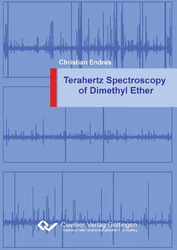| Fachbereiche | |
|---|---|
| Buchreihen (96) |
1378
|
| Nachhaltigkeit |
3
|
| Gesundheitswesen |
1
|
| Geisteswissenschaften |
2365
|
| Naturwissenschaften |
5406
|
| Mathematik | 229 |
| Informatik | 319 |
| Physik | 980 |
| Chemie | 1363 |
| Geowissenschaften | 131 |
| Humanmedizin | 243 |
| Zahn-, Mund- und Kieferheilkunde | 10 |
| Veterinärmedizin | 108 |
| Pharmazie | 147 |
| Biologie | 835 |
| Biochemie, Molekularbiologie, Gentechnologie | 121 |
| Biophysik | 25 |
| Ernährungs- und Haushaltswissenschaften | 45 |
| Land- und Agrarwissenschaften | 1004 |
| Forstwissenschaften | 201 |
| Gartenbauwissenschaft | 20 |
| Umweltforschung, Ökologie und Landespflege | 148 |
| Ingenieurwissenschaften |
1793
|
| Allgemein |
98
|
|
Leitlinien Unfallchirurgie
5. Auflage bestellen |
|
Erweiterte Suche
Terahertz Spectroscopy of Dimethyl Ether
Christian Endres (Autor)Vorschau
Inhaltsverzeichnis, Datei (49 KB)
Leseprobe, Datei (79 KB)
Dimethyl ether is one of the largest organic molecules detected in the interstellar medium. It is highly abundant in star forming regions. As an asymmetric top molecule with two methyl groups which undergo large amplitude motions and a moderately large dipole moment, it conveys a dense spectrum throughout the terahertz region and contributes to the spectral line confusion in astronomical observations at these frequencies.
In the scope of this thesis, the rotational spectrum of dimethyl ether has been investigated by means of high resolution spectroscopy in order to improve the understanding of the internal rotation dynamics and to provide comprehensive datasets for astronomical applications. Spectra have been recorded up to 2.1 THz. Their analysis allowed to provide accurate frequency predictions for astronomical applications, which enabled the first interstellar detection of transitions within excited torsional states of dimethyl ether.
An important prerequisite for these measurements was the development of a new spectrometer, which extends the frequency coverage of the Cologne spectrometers considerably. This has been realized by the application of a novel type of frequency multiplier, a superlattice multiplier. High multiplication factors and frequencies up to 3.1 THz have been achieved and used to record spectra of rotational transitions of various molecules. Due to these properties these devices are also well suited as mixer elements in heterodyne receivers. This has been proved by the assembly of a heterodyne receiver working at room-temperature. Further investigations using extremely sensitive THz-heterodyne receivers have been carried out in order to explore their potential in scope of future applications.
| ISBN-13 (Printausgabe) | 3869555548 |
| ISBN-13 (Printausgabe) | 9783869555546 |
| ISBN-13 (E-Book) | 9783736935549 |
| Sprache | Englisch |
| Seitenanzahl | 162 |
| Auflage | 1 Aufl. |
| Band | 0 |
| Erscheinungsort | Göttingen |
| Promotionsort | Universität Köln |
| Erscheinungsdatum | 16.11.2010 |
| Allgemeine Einordnung | Dissertation |
| Fachbereiche |
Physik
|








